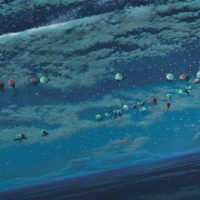37. TIM STORRIER

Storrier is an artist who is primarily concerned with painting the landscape, however not in a traditional sense. The artist uses landscape in his works as a stage on which to present scenes of human nature: drama, disaster, travel and dreams. Few artists of the late twentieth century have explored the landscape in such detail as Storrier the genre was so thoroughly dominated in the early twentieth century by artists such as Arthur Streeton (1867-1943),
Tom Roberts (1856-1931), Arthur Boyd (1920-1999) and Sidney Nolan (1917-1992) that more recently, many artists have chosen to avoid the subject. Storrier has chosen to tap into the historic tradition of landscape painting in a contemporary context he brings to it his own characteristic visual language which has become the oeuvre responsible for his immense critical and commercial success both in Australia and internationally.
The present work, Serendipity (Dance to the Music of Time) is a departure from the landscapes which Storrier is most well-known for: his burning objects beneath a sky littered with stars or clouds. Here, Storrier presents a unique perspective of the landscape albeit with all the scale and beauty which is expected in his work. Serendipity (Dance to the Music of Time) depicts an unmistakably Australian panorama of the parched interior; dried creeks and river beds can be seen from above, with clouds casting shadows from the moonlight. Storrier first used the floating perspective in the 1970s, he would paint structures from above creating a sense of looking down into the composition. The artists work Retreat, painted in 1972, demonstrates the technique Storriers viewpoint is taken from above the brick structure which is depicted in the composition, the same floating perspective he employs in the present work. Storrier has revisited this technique here with great success, his use of a diagonal horizon emphasises the floating effect and creates an atmosphere of dreamy euphoria tinged with tension.
Storrier has always been concerned with the enduring challenge of painting as a practice: with the tension between the representational and decorative function of art, with the compositional relationship between harmony and inventive discord1 The power within Storriers compositions stems from the tension which he creates by setting up dichotomies within his works. His beautifully painted works are full of imagery which is familiar yet there is almost always a fundamental incongruity within the painting: a tension between the real and the unreal. Here, Storrier carefully creates a slight sense of unease through the offset horizon as a backdrop to the otherwise spectacular evening sky. The artist adds further tension with his placement of a garland of roses which floats in the foreground juxtaposed against a burning piece of paper.
Storriers choice of title adds to the mood of the painting, the word serendipity being known to most as a happy accident or a pleasant surprise. The word serendipity was coined by art historian Horace Walpole (1717-1797) when he explained an unexpected discovery he had made by reference to a Persian fairy tale, The Three Princes of Serendip. In this story, the princes were always making discoveries by accident and without intending to, hence the notion of serendipity. Perhaps Storrier is suggesting here a serendipitous presence is at play within the work, or has been. How is it that we are floating, or falling, through the clouds in an evening sky strewn with brilliant stars? How did we get here? Where are we going?
Serendipity (Dance to the Music of Time) reinforces Storriers position as a highly accomplished painter of landscapes, not simply a landscape painter but an artist who uses nature as a stage on which to present scenes of human nature. His characteristically vast and beautifully composed canvasses are a pleasure to behold however on a deeper level, they are also explorations of the relationship between beauty and decay, design and decomposition, artistic control and creative flux it is the tension between these elements in his work that marks him out as one of Australias most popular yet simultaneously elusive modern artists.2
Footnotes
1. Lumby, C., Tim Storrier: The Art of the Outsider, Craftsman House, Sydney, 2000, p.141
2. ibid, p.11
Caroline Jones BA, MArtAdmin